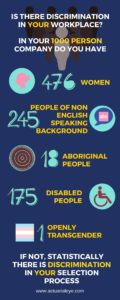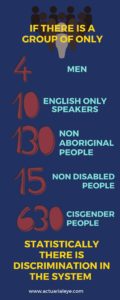 Sitting in a meeting of my industry peers this week, I did what I often did, and tried to count the proportion of women in the room. Luckily, for a change, I wasn’t the only woman. There were three of us out of 20! So I calculated the minimum number of women there have to be in a group of 20 to be 95% confident there is no discrimination. Fortunately, one of my kids has done the maths for me, and even better, given me some other groups that are often discriminated against to check.
Sitting in a meeting of my industry peers this week, I did what I often did, and tried to count the proportion of women in the room. Luckily, for a change, I wasn’t the only woman. There were three of us out of 20! So I calculated the minimum number of women there have to be in a group of 20 to be 95% confident there is no discrimination. Fortunately, one of my kids has done the maths for me, and even better, given me some other groups that are often discriminated against to check.
In a group of 20 people, if there are not at least 6 women, then the group has almost certainly been chosen using some form of discrimination – the characteristic of being a woman was a factor in how the group was chosen.
Another similar interesting statistic – how big does an all male group need to be before it is almost certain that some form of discrimination has chosen it? Four
Next time you see a panel of four men at a conference, there is only a 5% chance that discrimination hasn’t occurred somewhere in choosing that panel.
The calculation is that the size of the group (n) = 1.96^2*(1-p)/p
For other groups often discriminated against that less obviously visible (and less than 50% of the population):
- 10 People who don’t speak a language other than English at home is very likely to be discriminatory – 27.3% of the population (Australian census 2016)
- 133 people without an aboriginal and/or Torres Strait Islander is very likely to be discriminatory – 2.8% (Australian census 2016)
- 114 adults in Australia who all identify as heterosexual is very likely to be discriminatory – 3.1% of the adult male population and 3.4% of the adult female population (Australian population studies (pdf))
- 15 adults in Australia without someone with a disability is very likely to be discriminatory – 1 in 5 of the population has a disability (Australian network on disability)
- 636 adults without someone who is openly transgender or non binary is very likely to be discriminatory – 0.6% of the adult population (NY Times, a US stat because I couldn’t find an Australian one)
 Other than my male/female example, all of my others are not as visible. It isn’t necessarily obvious by looking or listening to someone whether they are of non English speaking background, indigenous, heterosexual, disabled, or transgender.
Other than my male/female example, all of my others are not as visible. It isn’t necessarily obvious by looking or listening to someone whether they are of non English speaking background, indigenous, heterosexual, disabled, or transgender.
So without discrimination choosing the group, if you are in a group of:
- 2 people, there is a 50% chance one of them speaks a language other than English at home
- 24 people, there is a 50% chance one of them will be indigenous
- 21 people, there is a 50% chance one of them will not be heterosexual
- 3 people, there is a 50% chance on of them will be disabled in some way
- 115 people, there is a 50% chance one of them will be openly transgender or non binary
If that person isn’t you, pay attention to the many diversities which could potentially be in the group you are in.

This analysis is correct only if the selection of the individuals to make up the group is done on a random drawing of people from the population. Very few groups are formed like this, even if were remotely possible to do so. With particular regard to workforce groups, it is clearly not the case that the individuals are randomly drawn from the population. They are selected because they have the rights skills and attributes that the employer needs. Further, they were free and able to join that group at the time the opportunity arose. Consequently, the subset of the population from which the selection is made is not a representative sample of the population and therefore no conclusions about discrimination likelihoods by age, gender, ethnicity, disablement, sexuality etc etc is possible.
Your comment is why I referred to discrimination in the system, rather than in the specific selection of the groups. For example, high school students with enough higher maths to become actuaries are disproportionately male. The selection from those students of graduate actuarial hires probably doesn’t involve discrimination. But there was discrimination somewhere in the system so that not as many girls did higher level maths at school.